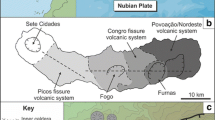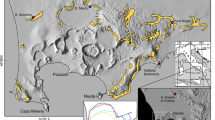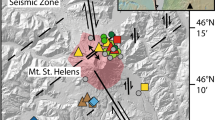Abstract
The climactic eruption of Mount Mazama has long been recognized as a classic example of rapid eruption of a substantial fraction of a zoned magma body. Increased knowledge of eruptive history and new chemical analyses of ∼350 wholerock and glass samples of the climactic ejecta, preclimactic rhyodacite flows and their inclusions, postcaldera lavas, and lavas of nearby monogenetic vents are used here to infer processes of chemical evolution of this late Pleistocene — Holocene magmatic system. The 6845±50 BP climactic eruption vented ∼50 km3 of magma to form: (1) rhyodacite fall deposit; (2) welded rhyodacite ignimbrite; and (3) lithic breccia and zoned ignimbrite, these during collapse of Crater Lake caldera. Climactic ejecta were dominantly homogeneous rhyodacite (70.4±0.3% SiO2), followed by subordinate andesite and cumulate scoriae (48–61% SiO2). The gap in wholerock composition reflects mainly a step in crystal content because glass compositions are virtually continuous. Two types of scoriae are distinguished by different LREE, Rb, Th, and Zr, but principally by a twofold contrast in Sr content: High-Sr (HSr) and low-Sr (LSr) scoriae. HSr scoriae were erupted first. Trace element abundances indicate that HSr and LSr scoriae had different calcalkaline andesite parents; basalt was parental to some mafic cumulate scoriae. Parental magma compositions reconstructed from scoria wholerock and glass data are similar to those of inclusions in preclimactic rhyodacites and of aphyric lavas of nearby monogenetic vents.
Preclimactic rhyodacite flows and their magmatic inclusions give insight into evolution of the climactic chamber. Evolved rhyodacite flows containing LSr andesite inclusions were emplaced between ∼30000 and ∼25000 BP. At 7015±45 BP, the Llao Rock vent produced a zoned rhyodacite pumice fall, then rhyodacite lava with HSr andesite inclusions. The Cleetwood rhyodacite flow, emplaced immediately before the climactic eruption and compositionally identical to climactic rhyodacite (volatile-free), contains different HSr inclusions from Llao Rock. The change from LSr to HSr inclusions indicates replenishment of the chamber with andesite magma, perhaps several times, in the latest Pleistocene to early Holocene.
Modeling calculations and wholerock-glass relations suggest than: (1) magmas were derived mainly by crystallization differentiation of andesite liquid; (2) evolved preclimactic rhyodacite probably was derived from LSr andesite; (3) rhyodacites contain a minor component of partial melt from wall rocks, and (4) climactic and compositionally similar rhyodacites probably formed by mixing of evolved rhyodacite with HSr derivative liquid(s) after replenishment of the chamber with HSr andesite magma. Density considerations permit a model for growth and evolution of the chamber in which andesite recharge magma ponded repeatedly between cumulates and rhyodacite magma. Convective cooling of this andesite resulted in rapid crystallization and upward escape of buoyant derivative liquid which mixed with overlying, convecting rhyodacite. The evolved rhyodacites were erupted early in the chamber's history and(or) near its margins. Postcaldera andesite lavas may be hybrids composed of LSr cumulates mixed with remnant climactic rhyodacite. Younger postcaldera rhyodacite probably formed by fractionation of similar andesite and assimilation of partial melts of wallrocks.
Uniformity of climactic rhyodacite suggests homogeneous silicic ejecta from other volcanoes resulted from similar replenishment-driven convective mixing. Calcalkaline pluton compositions and their internal zonation can be interpreted in terms of the Mazama system frozen at various times in its history.
Similar content being viewed by others
References
Albarede F, Bottinga Y (1972) Kinetic disequilibrium in trace element partitioning between phenocrysts and host lava. Geochim Cosmochim Acta 36:141–156
Anderson AT (1976) Magma mixing: petrological process and volcanological tool. J Volcanol Geotherm Res 1:3–33
Arculus RJ, Wills KJA (1980) The petrology of plutonic blocks and inclusions from the Lesser Antilles island arc. J Petrol 21:743–799
Arth JG (1976) Behavior of trace elements during magmatic processes — a summary of theoretical models and their applications. J Res US Geol Surv 4:41–47
Bacon CR (1983) Eruptive history of Mount Mazama and Crater Lake caldera, Cascade Range, USA. J Volcanol Geotherm Res 18:57–115
Bacon CR (1985) Implications of silicic vent patterns for the presence of large crustal magma chambers. J Geophys Res 90:11243–11252
Bacon CR (1986) Magmatic inclusions in silicic and intermediate volcanic rocks. J Geophys Res 91: 6091–6112
Bacon CR, Lanphere MA (1983) K-Ar chronology of eruptions at Mount Mazama before the formation of Crater Lake caldera. Trans Am Geophys Union 64 no. 45:879
Bacon CR, Hildreth W, Druitt TH (1987) Partition coefficients determined from phenocryst and glass analyses of the climactic ejecta of Mount Mazama, Oregon. US Geol Surv Open-file Rep 87-589, p.4
Barnes CG, Allen CM, Saleeby JB (1986) Open- and closed-system characteristics of a tilted plutonic system, Klamath Mountains, California. J Geophys Res 91:6073–6090
Bateman PC, Chappel BW (1979) Crystallization, fractionation, and solidification of the Tuolumne intrusive series, Yosemite National Park, California. Geol Soc Am Bull 90:465–482
Beard JS (1986) Characteristic mineralogy of arc-related cumulate gabbros: implications for the tectonic setting of gabbroic plutons and for andesite genesis. Geology 14:848–851
Best MG (1963) Petrology of the Guadalupe Igneous Complex, southwestern Sierra Nevada foothills, California. J Petrol 4:223–259
Blake S (1981) Eruptions from zoned magma chambers. J Geol Soc London 138:281–287
Blake S, Ivey GN (1986) Magma-mixing and the dynamics of withdrawal from stratified reservoirs. J Volcanol Geotherm Res 27:153–178
Bruggman PE, Bacon CR, Aruscavage PJ, Lerner RW, Schwarz LJ, Stewart KC (1987) Chemical analyses of rocks and glass separates from Crater Lake National Park and vicinity, Oregon. US Geol Surv Open-file Rep 87-57:36
Byrne JV (1962) Bathymetry of crater lake, Oregon. Oregon Dept Geol Min Ind, The Ore Bin 24:161–164
Campbell IH, Turner JS (1986) The influence of viscosity on fountains in magma chambers. J Petrol 27:1–30
Cantagrel JM, Gourgaud A, Robin C (1984) Repetitive mixing events and Holocene pyroclastic activity at Pico de Orizaba and Popocatepetl (Mexico). Bull Volcanol 47-7:735–748
Condie KC, Swenson DH (1973) Compositional variation in three Cascade stratovolcanoes: Jefferson, Rainier, and Shasta. Bull Volcanol 37:205–230
Conrad WK, Kay RW (1984) Ultramafic and mafic inclusions from Adak Island: crystallization history, and implications for the nature of primary magmas and crustal evolution in the Aleutian arc. J Petrol 25:88–125
Diller JS, Patton HB (1902) The geology and petrography of Crater Lake National Park. US Geol Surv Prof Pap 3:167
Druitt TH, Bacon CR (1986) Lithic breccia and ignimbrite erupted during the collapse of Crater Lake caldera, Oregon. J Volcanol Geotherm Res 29:1–32
Eichelberger JC (1975) Origin of andesite and dacite: evidence of mixing at Glass Mountain in California and at other circum-Pacific volcanoes. Geol Soc Am Bull 86:1381–1391
Eichelberger JC (1980) Vesiculation of mafic magma during replenishment of silicic magma reservoirs. Nature 288:446–450
Eichelberger JC, Carrigan CR, Westrich HR, Price RH (1986) Non-explosive silicic volcanism. Nature 323:598–602
Ewart A (1979) A review of the mineralogy and chemistry of Tertiary-recent dacitic, latitic, rhyolitic, and related salic volcanic rocks. In: Barker F (ed) Trondhjemites, dacites, and related rocks. Dev Petrol 6:13–121
Flood RH, Shaw SE (1979) K-rich cumulate diorite at the base of a tilted granodiorite pluton from the New England batholith, Australia. J Geol 87:417–425
Frost TP, Mahood GA (1987) Field, chemical, and physical constraints on mafic-felsic magma interaction in the Lamarck Granodiorite, Sierra Nevada, California. Geol Soc Am Bull 99:272–291
Fujimaki H (1982) Basalt produced by mechanical mixing of andesite magma and gabbroic fragments: Hakone volcano and adjacent areas, Central Japan. J Volcanol Geotherm Res 12:111–132
Gardeweg M, Ramírez CF (1987) La Pacana caldera and the Atana Ignimbrite-A major ash-flow and resurgent caldera complex in the Andes of northern Chile. Bull Volcanol 49:547–566
Gill JB (1981) Orogenic andesites and plate tectonics. Springer, Berlin Heidelberg New York, p 390
Grove TL, Donnelly-Nolan JM (1986) The evolution of young silicic lavas at Medicine Lake Volcano, California: implications for the origin of compositional gaps in calc-alkaline series lavas. Contrib Mineral Petrol 92:281–302
Grove TL, Gerlach DC, Sando TW (1982) Origin of calc-alkaline series lavas at Medicine Lake Volcano by fractionation, assimilation and mixing. Contrib Mineral Petrol 80:160–182
Haskin LA, Haskin MA, Frey FA, Wildeman TR (1968) Relative and absolute terrestrial abundances of the rare earths. In: Ahrens LH (ed) Origin and distribution of the elements. Pergamon Press, pp 889–912
Helz RT (1988) Diapiric transfer of melt in Kilanea Iki lava lake: A quick, efficient process of igneous differentiation. Geol Soc Am Bull (in press)
Hildreth W (1981) Gradients in silicic magma chambers: implications for lithospheric magmatism. J Geophys Res 86:10153–10192
Hildreth W (1983) The compositionally zoned eruption of 1912 in the Valley of Ten Thousand Smokes, Katmai National Park, Alaska. J Volcanol Geotherm Res 18:1–56
Hill RI, Silver LT, Chappell BW, Taylor HP Jr (1985) Solidification and recharge of SiO2-rich plutonic magma chamber. Nature 313:643–646
Huppert HE, Sparks RSJ (1980) The fluid dynamics of a basaltic magma chamber replenished by influx of hot, dense ultrabasic magma. Contrib Mineral Petrol 75:279–289
Huppert HE, Sparks RSJ (1984) Double-diffusive convention due to crystallization in magmas. Ann Rev Earth Planet Sci 12:11–37
Huppert HE, Turner JS, Sparks RSJ (1982) Replenished magma chambers: effects of compositional zonation and input rates. Earth Planet Sci Lett 57:345–357
Irvine TN (1980) Magmatic infiltration metasomatism, double-diffusive fractional crystallization, and adcumulus growth in the Muskox Intrusion and other layered intrusions. In: Hargraves RB (ed) Physics of magmatic processes. Princeton University Press, pp 245–306
Irvine TN (1982) Terminology for layered intrusions. J Petrol 23:127–162
Irvine TN, Baragar WR (1971) A guide to the chemical classification of the common igneous rocks. Can J Earth Sci 8:523–548
Kerr RC, Tait SR (1985) Convective exchange between pore fluid and an overlying reservoir of denser fluid: a post-cumulus process in layered intrusions. Earth Planet Sci Lett 75:147–156
Koyaguchi T (1985) Magma mixing in a conduit. J Volcanol Geotherm Res 25:365–369
Lee DE, Christiansen EH (1983) The granite problem as exposed in the Southern Snake Range, Nevada. Contrib Mineral Petrol 83:99–116
LeMaitre RW (1981) Genmix — a generalized petrological mixing model program. Comput Geosci 7:229–247
Lidstrom JW Jr (1971) A new model for the formation of Crater Lake Caldera, Oregon. PhD thesis, Oregon State University Corvallis, p 85
Lipman PW (1967) Mineral and chemical variations within an ashflow sheet from Aso caldera, Southwestern Japan. Contrib Mineral Petrol 16:300–327
Lipman PW (1975) Evolution of the Platoro caldera complex and related volcanic rocks, southeastern San Juan Mountains, Colorado. US Geol Surv Prof Pap 852:128
Luhr JF, Carmichael ISE (1980) The Colima volcanic complex, Mexico. I. Post-caldera andesites from Volcan Colima. Contrib Mineral Petrol 71:343–372
Luhr JF, Carmichael ISE (1985) Jorullo Volcano, Michoacan, Mexico (1759–1774): the earliest stages of fractionation in calcalkaline magmas. Contrib Mineral Petrol 90:142–161
Mack S, Saleeby JB, Farrell JE (1979) Origin and emplacement of the Academy Pluton, Fresno County, California. Geol Soc Am Bull Part II 90:633–694
Marsh BD (1981) On the crystallinity, probability of occurrence, and rheology of lava and magma. Contrib Mineral Petrol 78:85–98
McBirney AR (1968) Compositional variations of the climactic eruption of Mount Mazama. In: Dole HM (ed) Andesite conference Guidebook. Oregon Dep Geol Mineral Ind Bull 62:53–56
McBirney AR (1980) Mixing and unmixing of magmas. J Volcanol Geotherm Res 7:357–371
McBirney AR, Baker BH, Nilson RH (1985) Liquid fractionation. Part I: Basic principles and experimental simulations. J Volcanol Geotherm Res 24:1–24
McCarthy TS, Groves DI (1979) The Blue Tier batholith, Northeastern Tasmania. Contrib Mineral Petrol 71:193–209
Merzbacher C, Eggler DH (1984) A magmatic geohygrometer: application to Mount St Helens and other dacitic magmas. Geology 12:587–590
Nelson CH, Carlson PR, Bacon CR (1987) The Mt Mazama climactic eruption (6900 BP) and resulting convulsive sedimentation on the continent, ocean basin, and Crater Lake caldera floor. In: Clifton HE (ed) Sedimentologic consequences of convulsive geologic events. Geol Soc Am Spec Pap (in press)
Noble DC, Drake JC, Whallon MK (1969) Some preliminary observations on compositional variations within the pumice- and scoria-flow deposits of Mount Mazama. In: McBirney AR (ed) Proceedings of the andesite conference. Oregon Dep Geol Mineral Ind Bull 65:157–164
Novak SW, Bacon CR (1986) Pliocene volcanic rocks of the Coso Range, Inyo County, California. US Geol Surv Prof Pap 1381:44
Peacock MA (1931) Classification of igneous rock series. J Geol 39:54–67
Pearce JA, Harris NBW, Tindle AG (1984) Trace element discrimination diagrams for the tectonic interpretation of granitic rocks. J Petrol 25:956–983
Perfit MR, Brueckner H, Lawrence JR, Kay RW (1980) Trace element and isotopic variations in a zoned pluton and associated volcanic rocks, Unalaska Island, Alaska: a model for fractionation in the Aleutian calcalkaline suite. Contrib Mineral Petrol 73:69–87
Richter FM, McKenzie D (1984) Dynamical models for melt segregation from a deformable matrix. J Geol 92:729–740
Ritchey JL (1979) Origin of divergent magmas at Crater Lake, Oregon. PhD thesis, University of Oregon, Eugene, p 209
Ritchey JL (1980) Divergent magmas at Crater Lake, Oregon: products of fractional crystallization and vertical zoning in a shallow, water-undersaturated chamber. J Volcanol Geotherm Res 7:373–386
Ritchey JL, Eggler DH (1978) Amphibole stability in a differentiated calc-alkaline magma chamber: an experimental investigation. Carnegie Inst Washington Yearb 77:790–793
Rutherford MJ, Devine JD (1987) The May 18, 1980, eruption of Mount St Helens. III. Stability and chemistry of amphibole in the magma chamber. J Geophys Res (in press)
Rutherford MJ, Sigurdsson H, Carey S, Davis A (1985) The May 18, 1980 eruption of Mount St Helens. I. Melt composition and experimental phase equilibria. J Geophys Res 90:2929–2947
Sakuyama M (1979) Evidence of magma mixing: petrological study of Shirouma-Oike calc-alkaline and andesite volcano, Japan. J Volcanol Geotherm Res 5:179–208
Sakuyama M (1984) Magma mixing and magma plumbing systems in island arcs. Bull Volcanol 47-4:685–703
Smith RL (1979) Ash-flow magmatism. Geol Soc Am Spec Pap 180:5–27
Smith TE, Huang CH, Walawender MJ, Cheung P, Wheeler C (1983) The gabbroic rocks of the Peninsular Ranges batholith, Southern California: cumulate rocks associated with calc-alkalic basalts and andesites. J Volcanol Geotherm Res 18:249–278
Snoke AW, Quick JE, Bowman HR (1981) Bear mountain igneous complex, Klamath Mountains, California; an ultrabasic to silicic calc-alkaline suite. J Petrol 22:501–552
Sparks RSJ, Marshall L (1986) Thermal and mechanical constraints on mixing between mafic and silicic magmas. J Volcanol Geotherm Res 29:99–124
Sparks RSJ, Sigurdsson H, Wilson L (1977) Magma mixing: a mechanism for triggering acid explosive eruptions. Nature 267:315–318
Sparks RSJ, Huppert HE, Turner JS (1984) The fluid dynamics of evolving magma chambers. Philos Trans R Soc London 310:511–534
Spera FJ, Yuen DA, Greer JC, Sewell G (1986) Dynamics of magma withdrawal from stratified magma chambers. Geology 14:723–726
Tait SR (1985) Fluid dynamic and geochemical evolution of cyclic unit 10, Rhum, eastern layered series. Geol Mag 122:469–484
Tait SR, Huppert HE, Sparks RSJ (1984) The role of compositional convection in the formation of adcumulate rocks. Lithos 17:139–146
Taylor BE, Eichelberger JC, Westrich HR (1983) Hydrogen isotopic evidence of rhyolitic magma degassing during shallow intrusion and eruption. Nature 306:541–545
Wager LR, Brown GM, Wadsworth WJ (1960) Types of igneous cumulates. J Petrol 1:73–85
Watson EB (1982) Basalt contamination by continental crust: some experiments and models. Contrib Mineral Petrol 80:73–87
Whalen JB (1985) Geochemistry of an island-arc plutonic suite: the Uasilau-Yau Yau intrusive complex, New Britain, PNG. J Petrol 26:603–632
Wiebe RA, Wild T (1983) Fractional crystallization and magma mixing in the Tigalak layered intrusion, the Nain anorthosite complex, Labrador. Contrib Mineral Petrol 84:327–344
Williams H (1942) The geology of Crater Lake National Park, Oregon. Carnegie Inst Washington Publ 540:162
Williams H (1961) The floor of Crater Lake, Oregon. Am J Sci 259:81–83
Author information
Authors and Affiliations
Rights and permissions
About this article
Cite this article
Bacon, C.R., Druitt, T.H. Compositional evolution of the zoned calcalkaline magma chamber of Mount Mazama, Crater Lake, Oregon. Contrib Mineral Petrol 98, 224–256 (1988). https://doi.org/10.1007/BF00402114
Received:
Accepted:
Issue Date:
DOI: https://doi.org/10.1007/BF00402114




